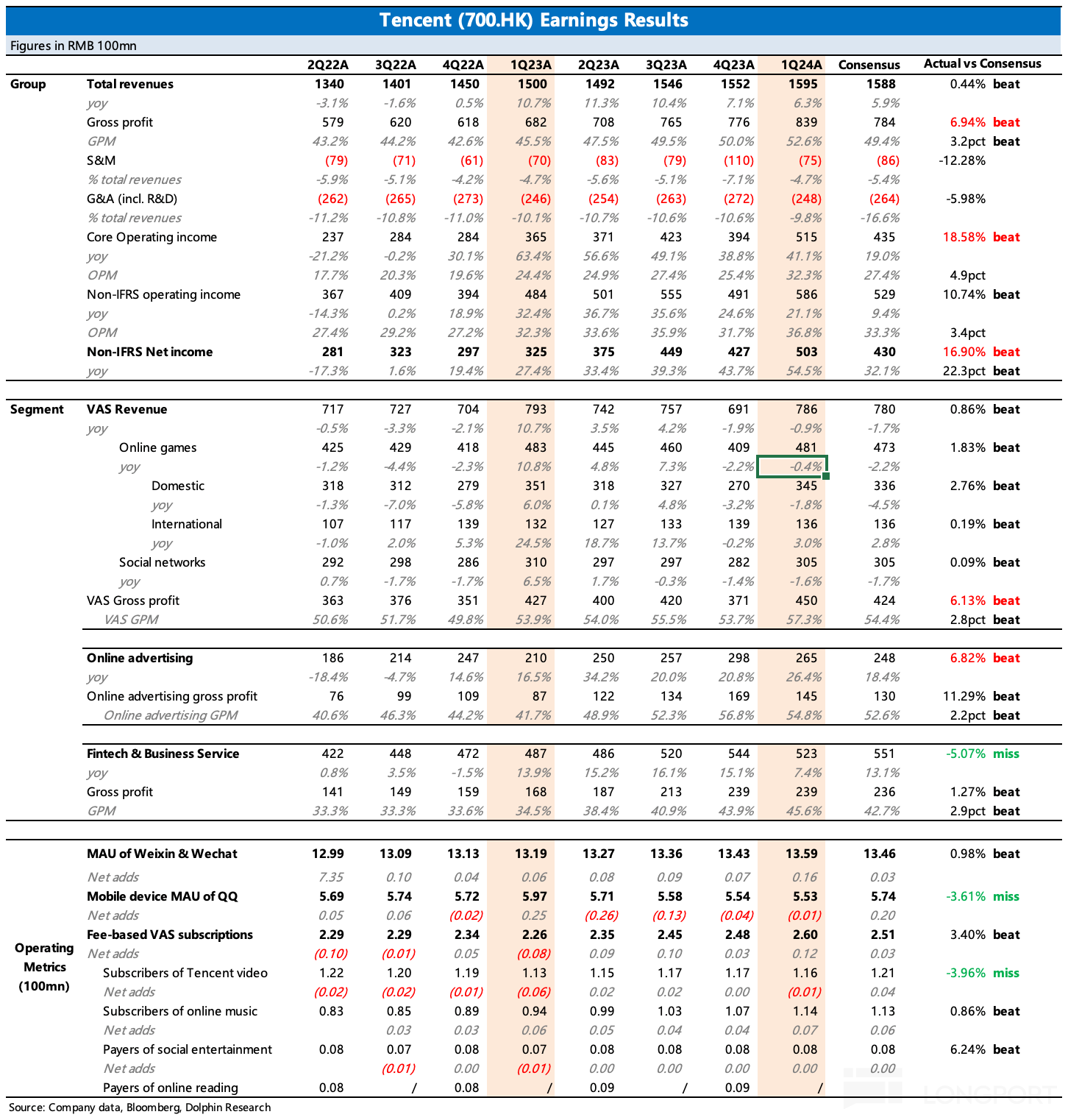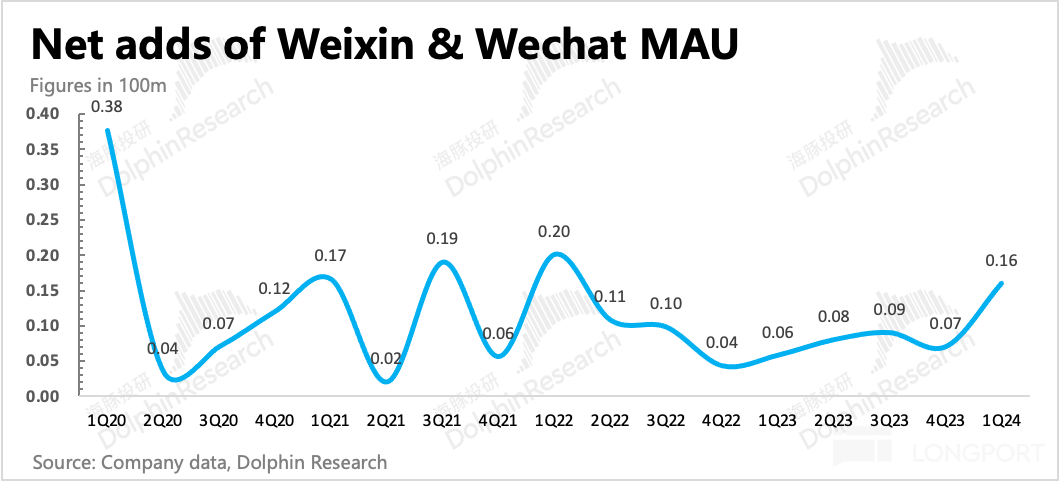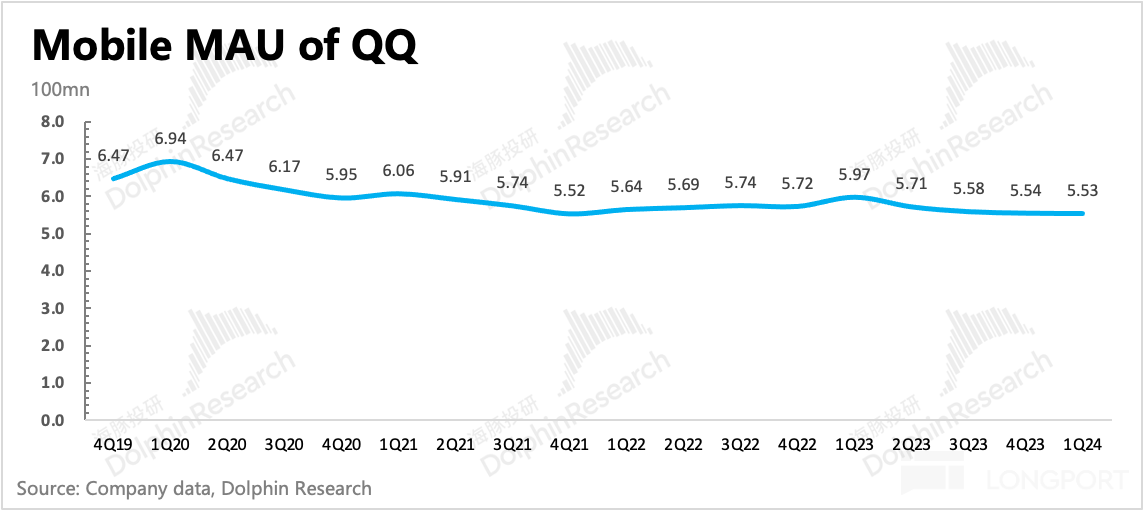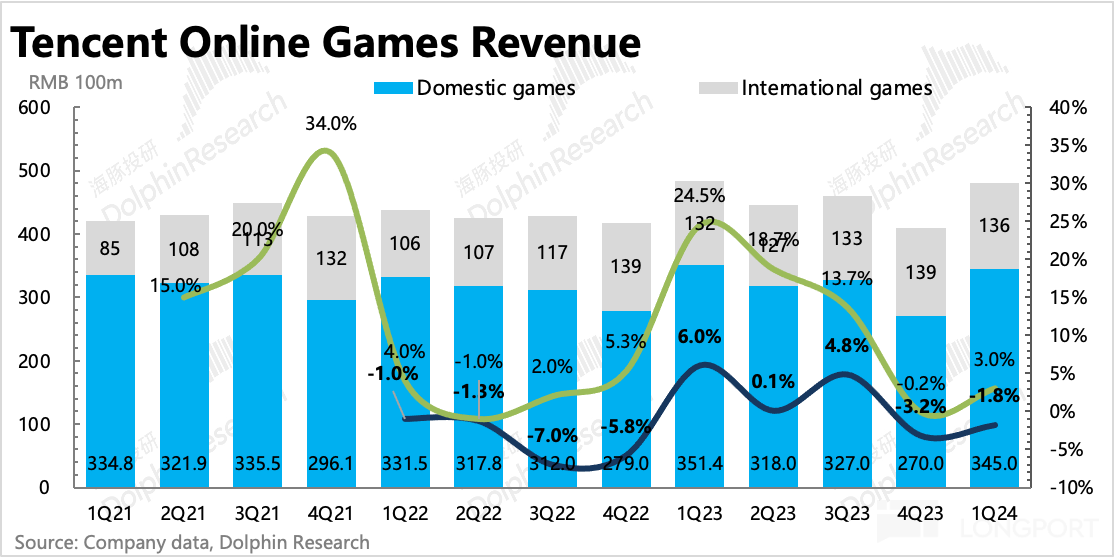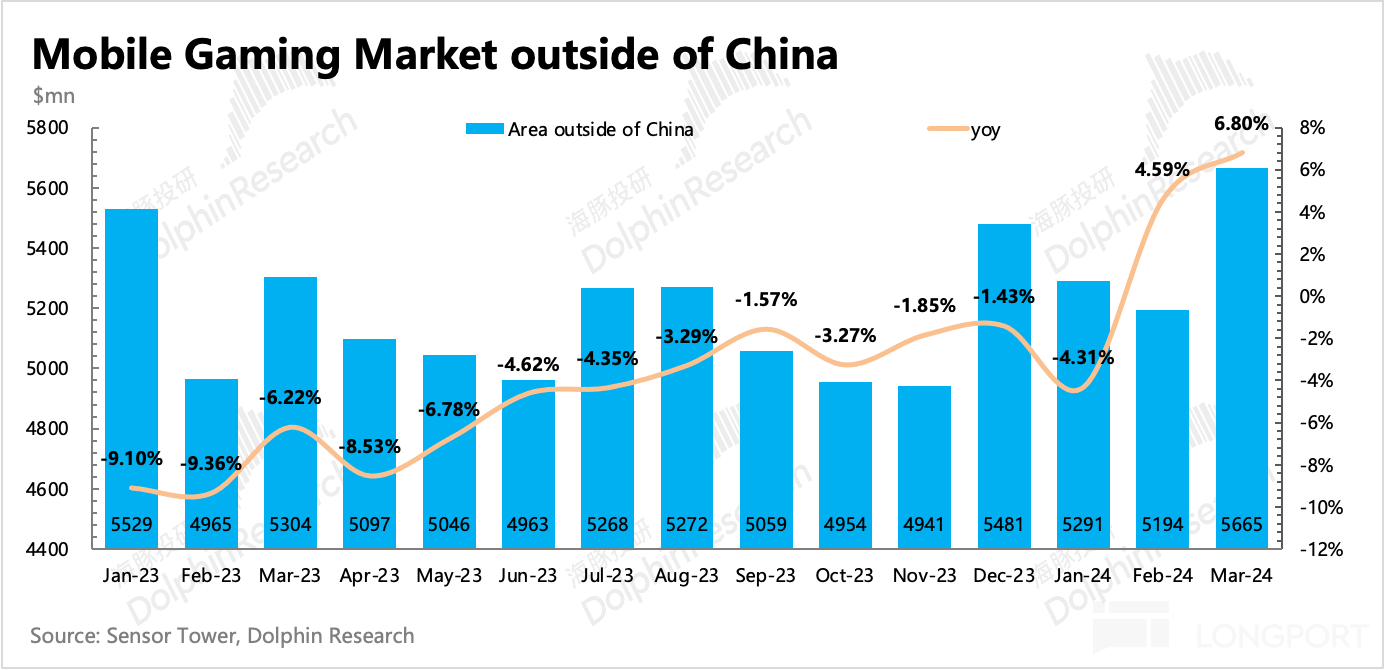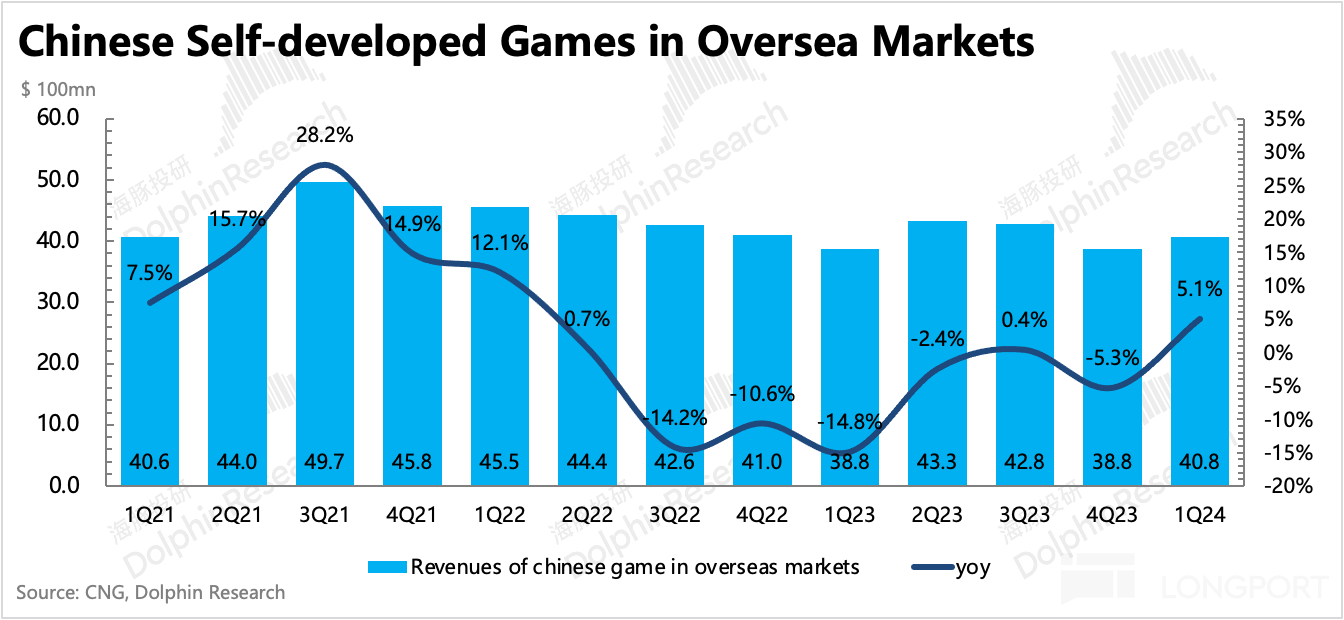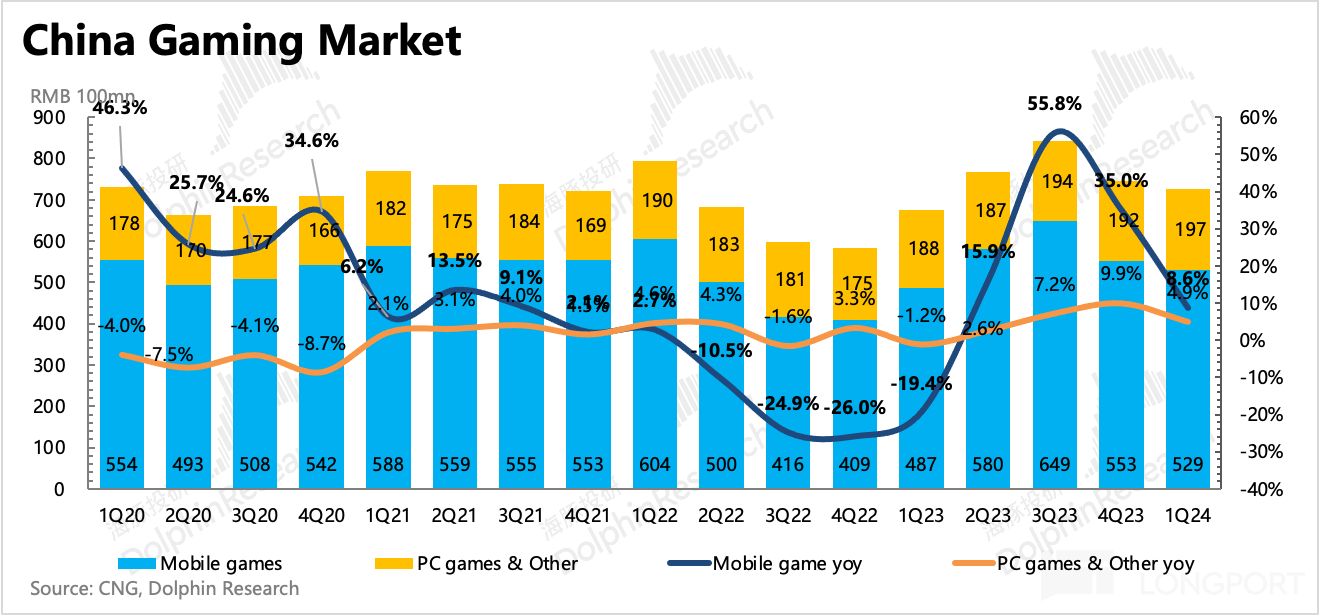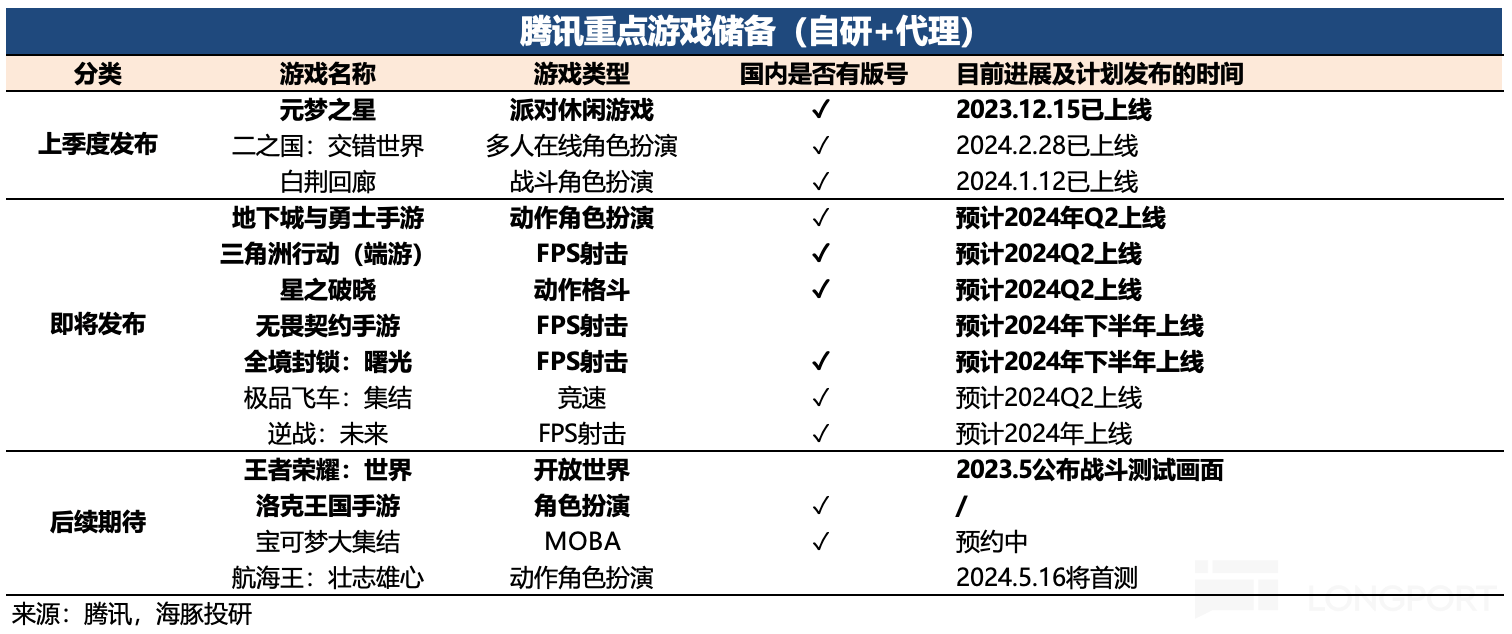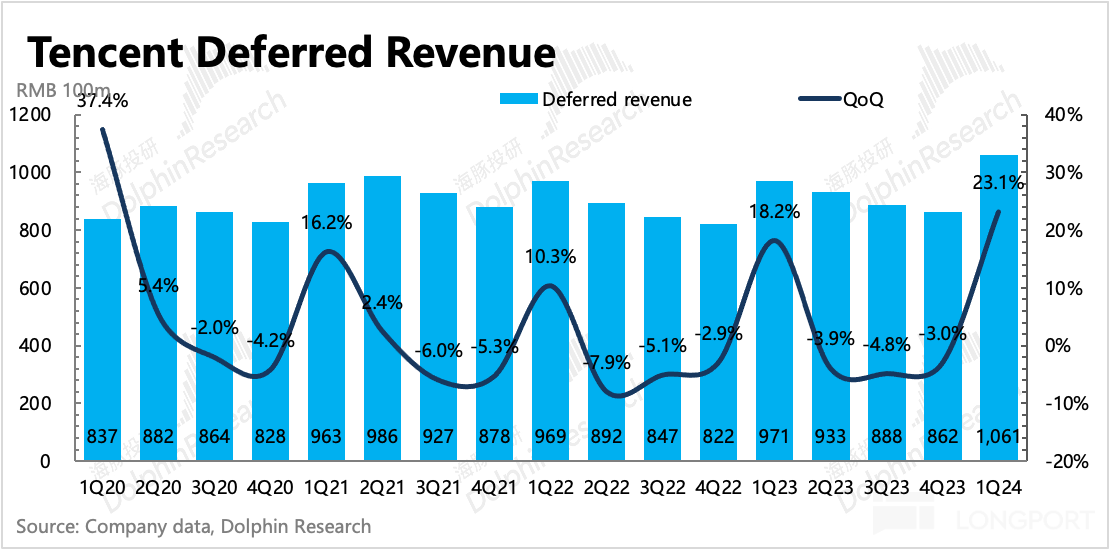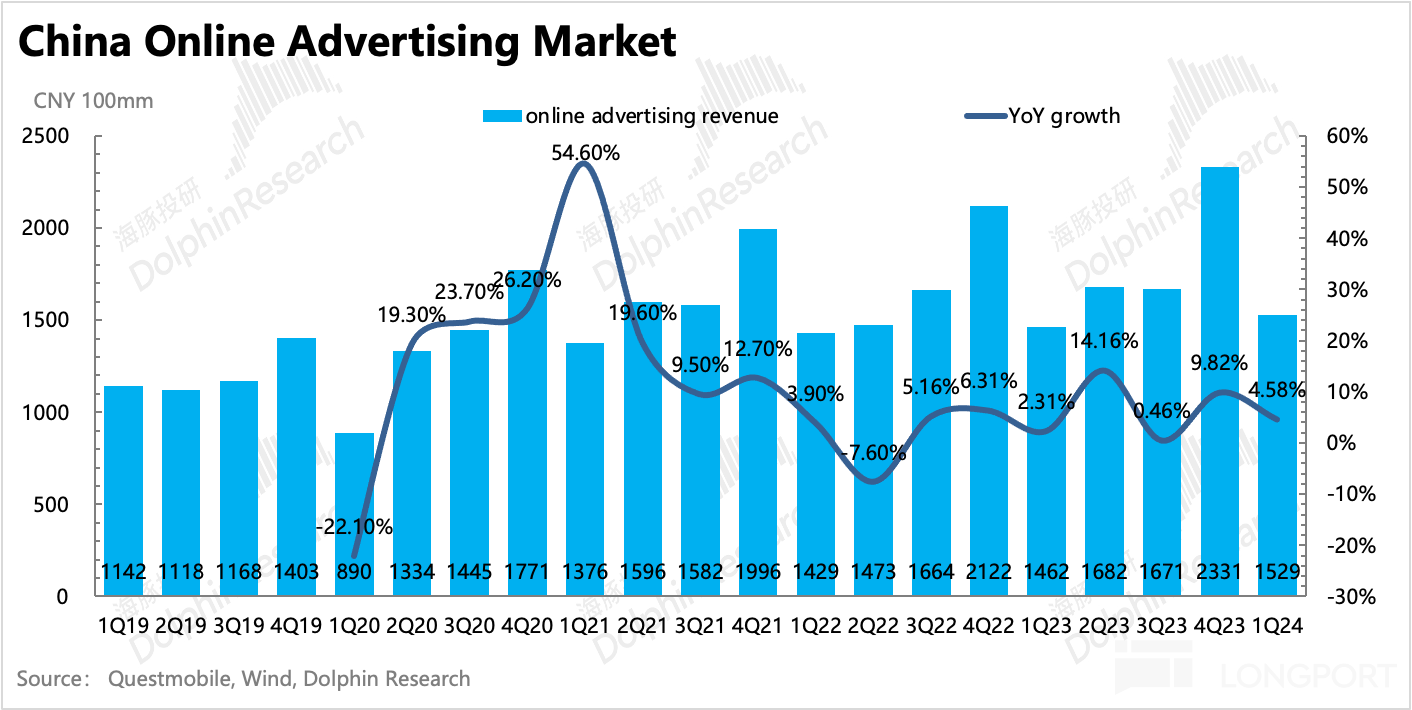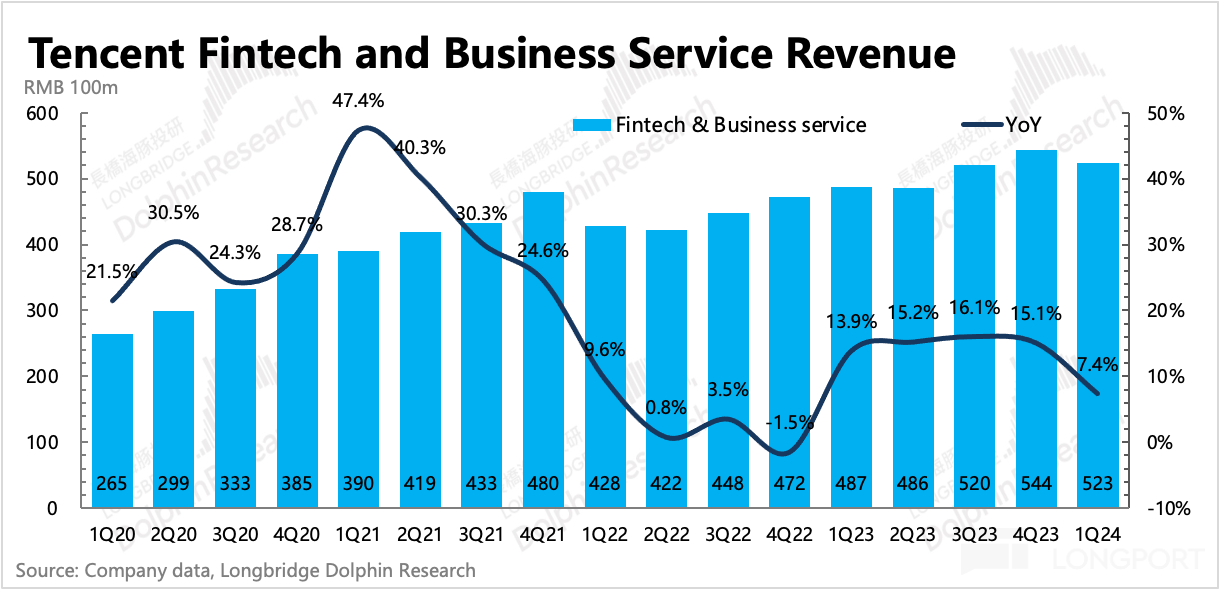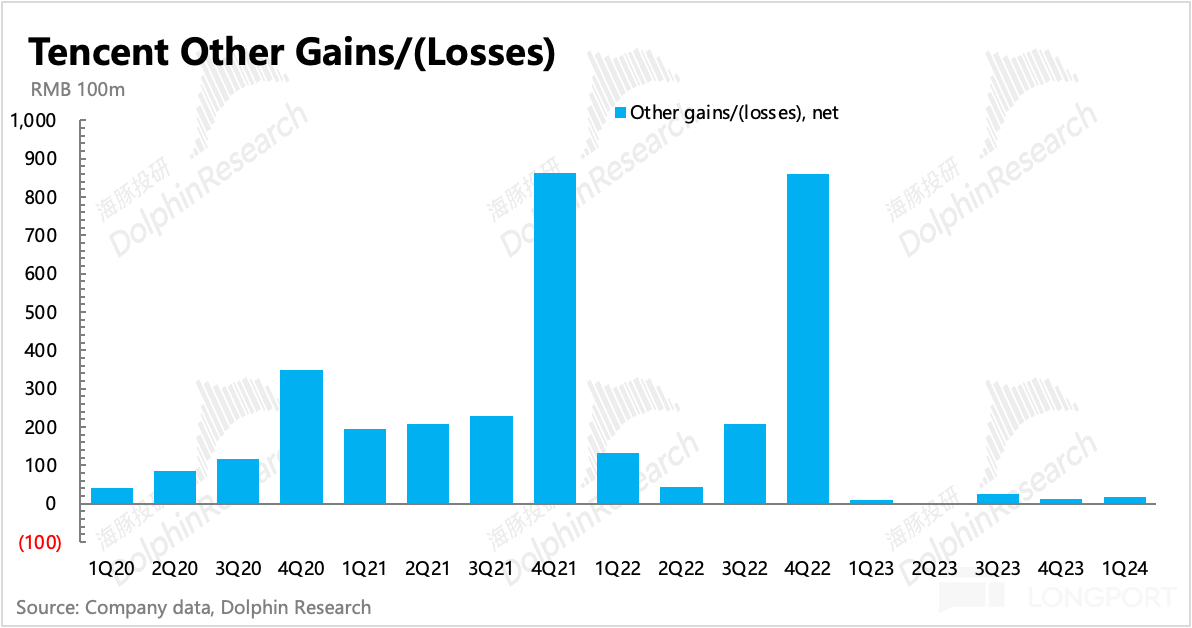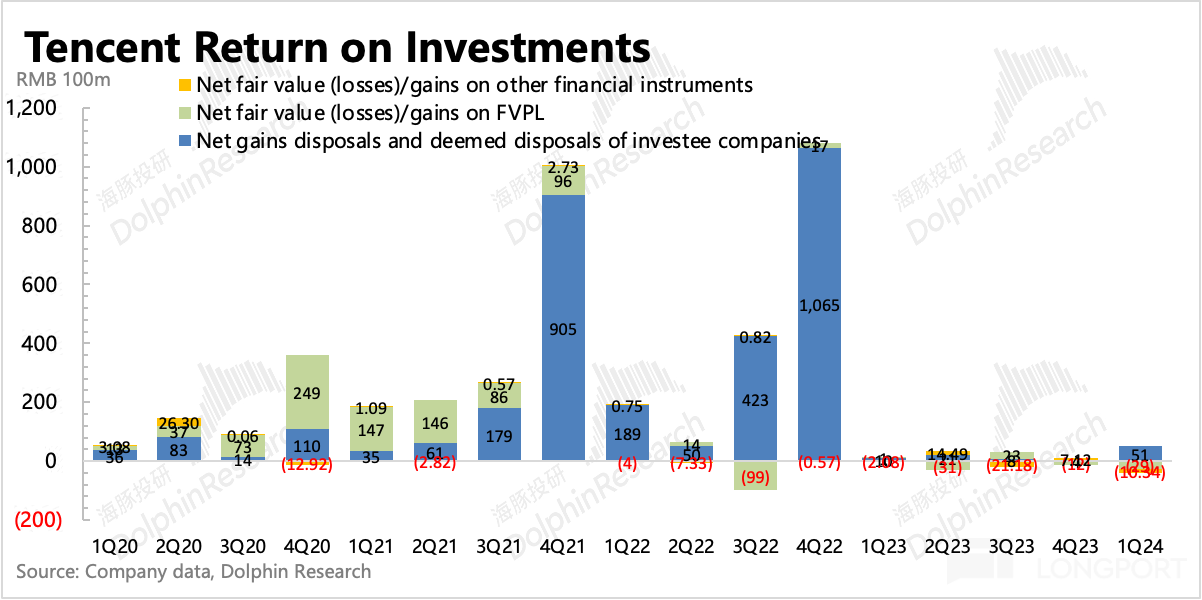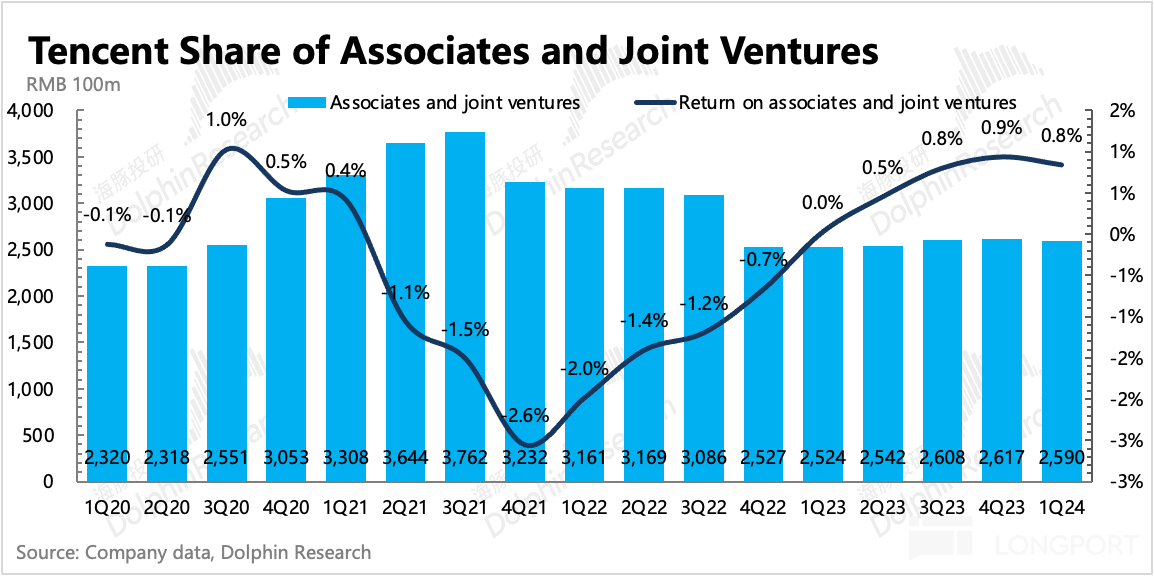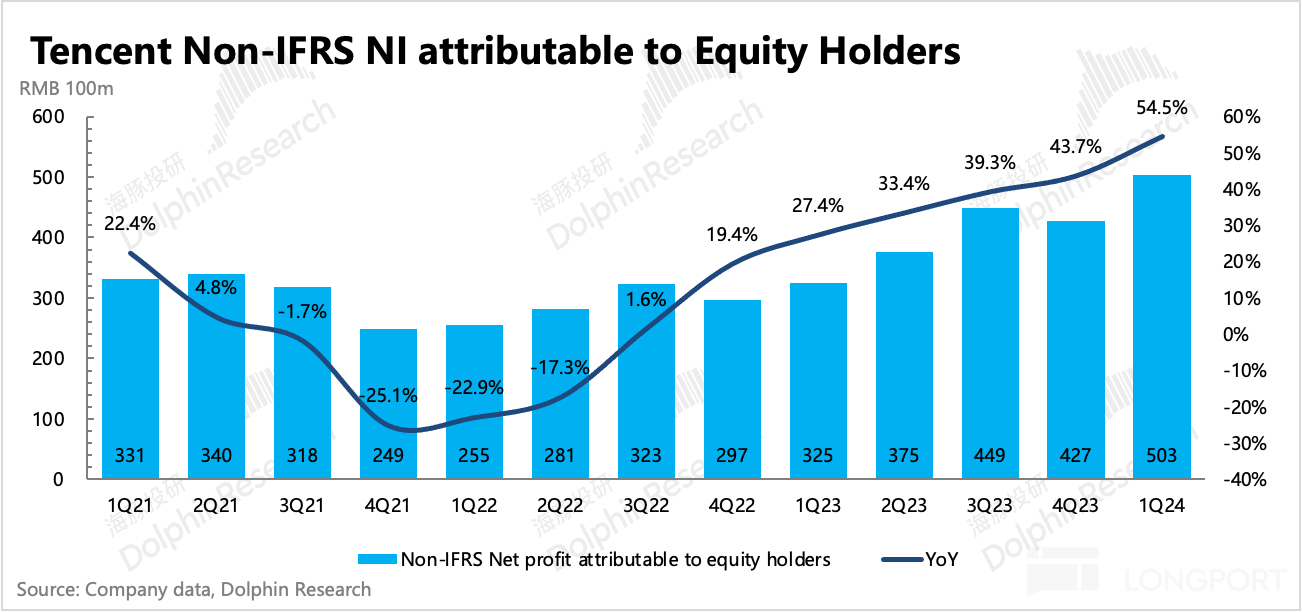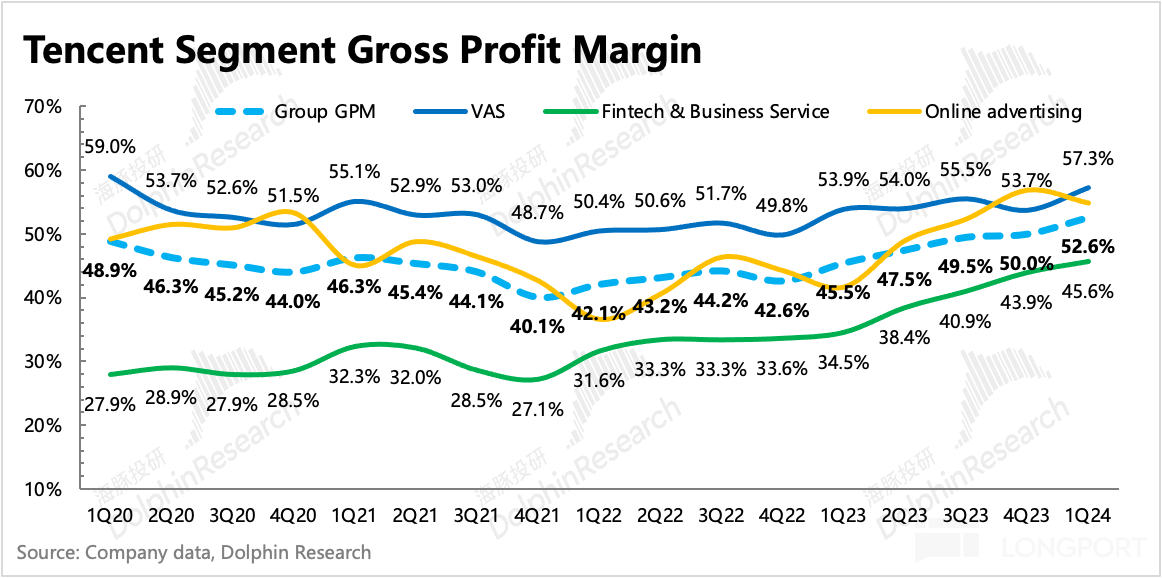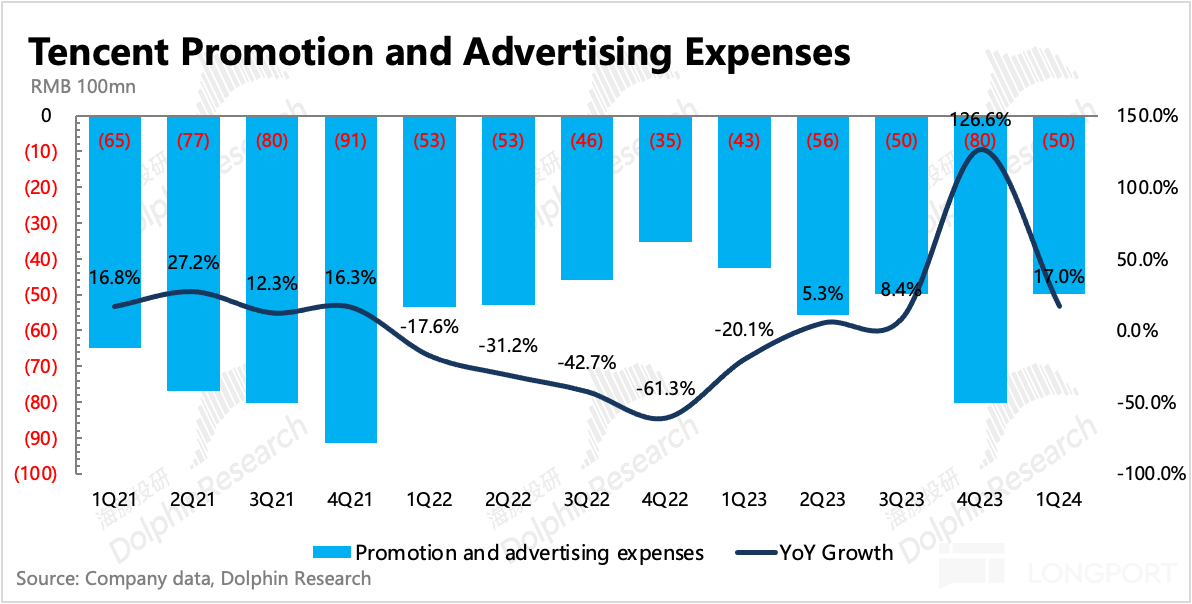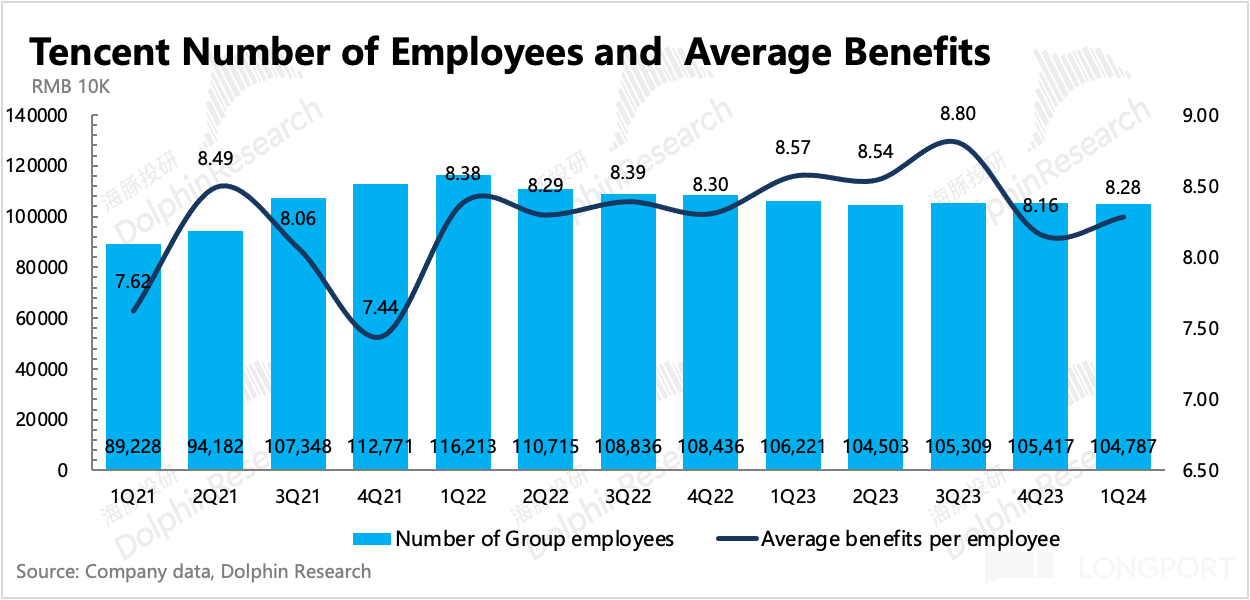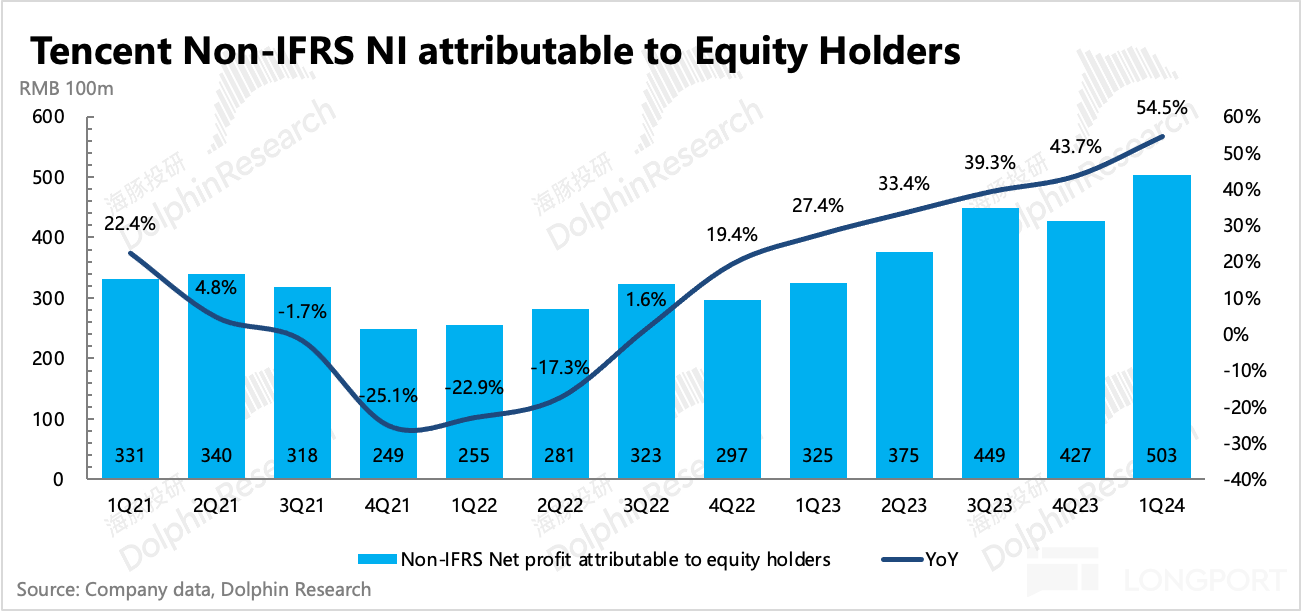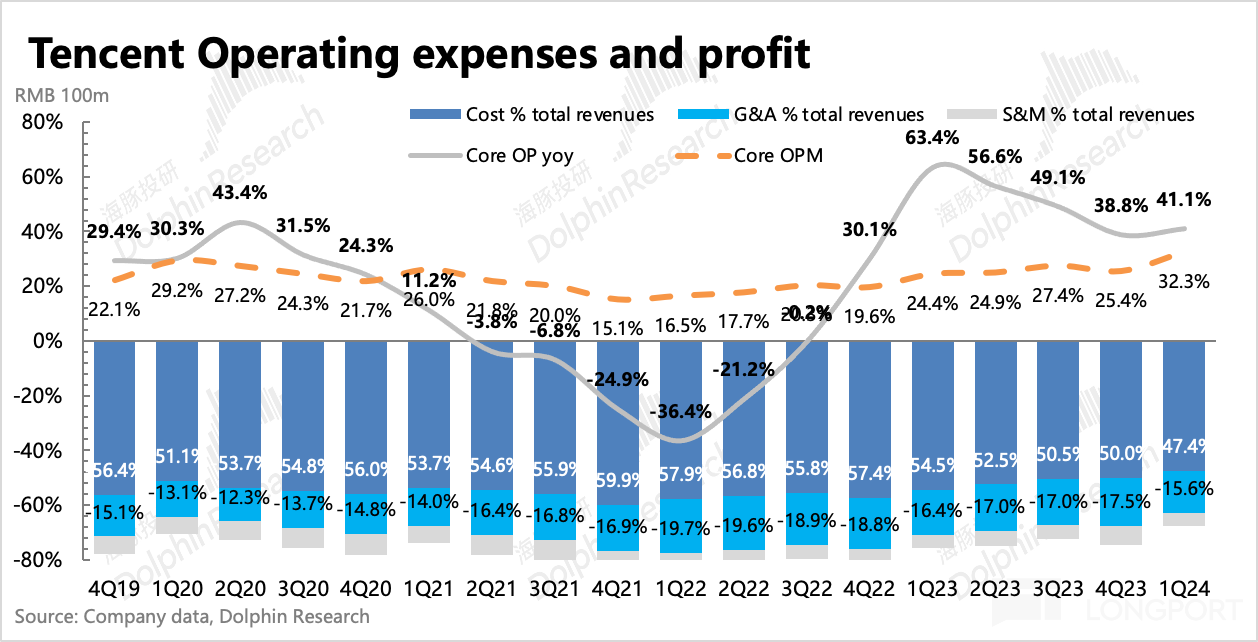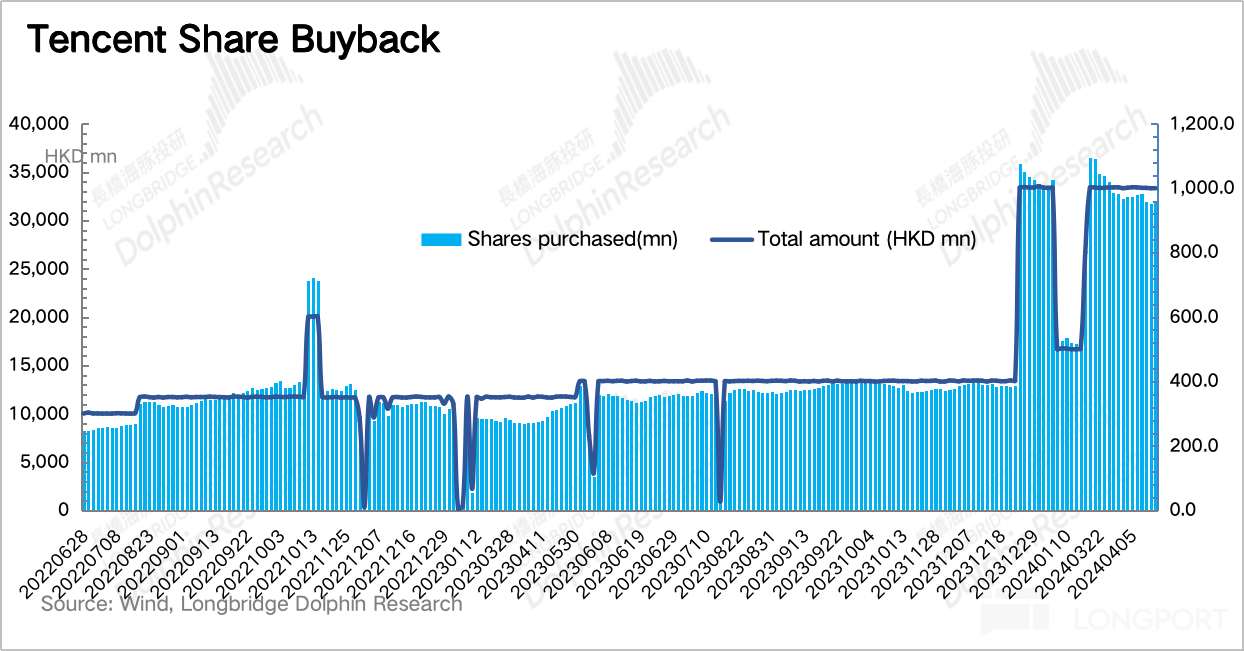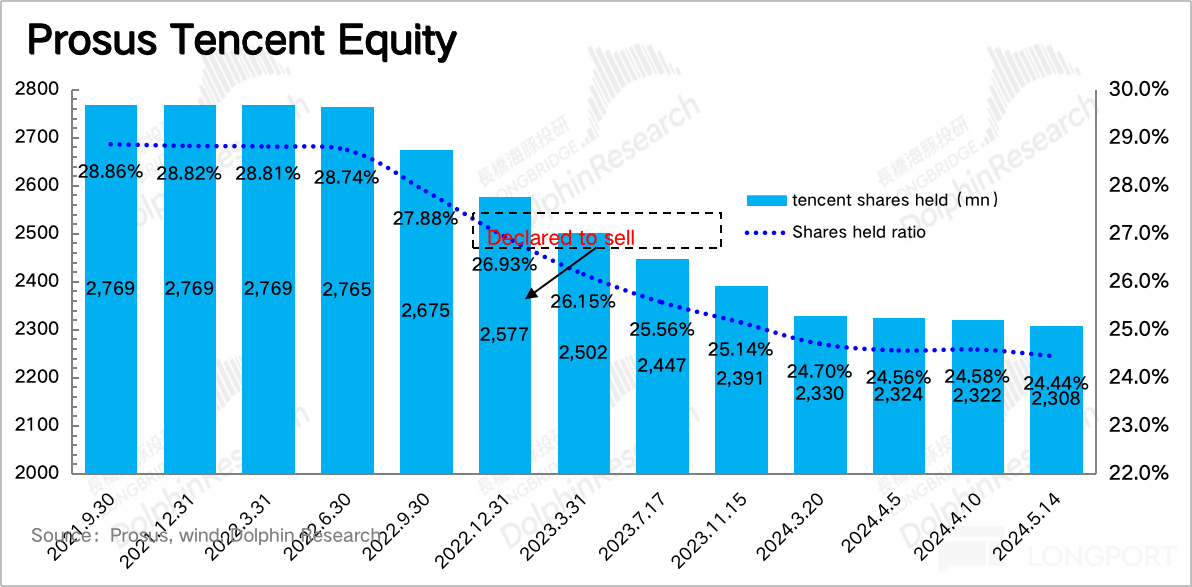
 Likes Received
Likes Received Posts
PostsTencent: Video account transforms into a money tree, stock king elegantly takes off

After the Hong Kong stock market closed on May 14th Beijing time, the first quarter report of $TENCENT.HK was released. Unlike the pressure on game business in the previous quarter and the expected slowdown in growth in high-base businesses such as advertising, the actual performance in the first quarter was good, especially with profits unexpectedly accelerating.
Overall, the revenue was basically in line, with the highlight being advertising significantly exceeding market expectations. We expect that the Video Number platform will contribute significantly, indicating that the performance of the Video Number platform in Q1 was very good, and it is expected to maintain high growth in the peak season of e-commerce in Q2.
Driven by high-margin advertising, mini-games, and commission income from Video Number, as well as cost reductions from optimization and layoffs, Non-IFRS net profit attributable to equity holders soared by 55% on a high base.
The current performance is in the past. Apart from the implied smooth progress of Video Number in advertising performance, from a medium to long-term perspective, there are three issues that Dolphin Jun is concerned about: games, efficiency improvement, and major shareholder sell-offs/buybacks, all of which currently show some easing and positive trends.
Specifically:
1. Advertising: Video Number's Contribution Exceeded Expectations
Since last year's Q1 had a high base, the market had lowered the growth rate trend to only around 18%. In reality, advertising revenue in the first quarter increased by 26% year-on-year, significantly exceeding market expectations.
Based on research, Dolphin Jun believes that the unexpected performance in advertising mainly comes from the pull of Video Number. On one hand, the traffic pool of Video Number is expanding continuously, with user time spent in Q1 increasing by 80% year-on-year. In addition, in information flow advertising, Video Number has increased the exposure of public domain content, thereby increasing inventory and conversion efficiency. On the other hand, the progress of e-commerce on Video Number is smooth. In addition to the natural growth at the initial stage, it has increased the proportion of e-commerce content traffic, making the e-commerce progress smooth, doubling the transaction volume, which naturally drives an increase in merchant advertising spending. Following this logic, in the e-commerce peak season of the second quarter, the pull of e-commerce on advertising will be more significant, thereby supporting continued high growth in advertising.
In addition to Video Number, the company also mentioned the promotion of AI-generated ads. Dolphin Jun believes that for advertisers, the overall advertising budget is relatively fixed unless consumer spending power takes another step up. When leading channels start using AI to improve ad conversion rates, companies return to the starting point of competition - competing for traffic strength.
2. Games: Signs of Improvement
Game revenue in the first quarter declined by 0.4% year-on-year, slightly exceeding market expectations. The difference in expectations mainly came from the performance of domestic revenue, which held up against last year's high base, with the actual decline (-1.8%) not as much as originally indicated (-5%).
Issues with games have been reflected in multiple quarterly reports, so the market will also pay more attention to future performance. Combining forward-looking data, Dolphin Jun believes that **Tencent mentioned game business restructuring and optimization in the previous quarter's conference call, and some effects can already be seen On the one hand, Q1 short-term deferred revenue increased by 23% month-on-month, indicating some support for the growth of game revenue in the next quarter, although it also includes deferred member payments from Tencent Music, Tencent Video, and Yuewen.
On the other hand, the company understands that the market is particularly concerned about the game business, and specifically highlighted the optimization progress of the game business at the beginning of the financial report. 1) Emphasized the significant commercialization improvement of "Honor of Kings" and "Peace Elite", with a return to positive growth in March. 2) Overseas games, such as a revamped old game "Brawl Stars" under Supercell, have seen a resurgence with double the daily active users compared to the same period last year, and a doubling of revenue year-on-year. Therefore, driven by the intensive launch of new games such as "DNF Mobile" in the second quarter, the recovery of the game business is likely to be faster than originally expected.
Of course, in the medium to long term, there is still a need for continuous high-quality new products and operational innovations for old games. These have been areas where Tencent has underperformed in the past few years, especially the former. Therefore, it is recommended to continue to pay attention to the company's further adjustments and optimizations in the game business.
3. Jinke Enterprise Service: Payment Slows Down, Video Number Commission Net Contribution Increases
In the first quarter, the financial technology and enterprise services grew by 7.4% year-on-year, lower than market expectations. This was mainly due to the slowdown in offline payments during the Chinese New Year period in the first quarter. This was not only reflected in WeChat Pay, but the overall performance of social retail in the first quarter was poor, coupled with a high base from last year, and the People's Bank of China disclosed that the year-on-year growth of third-party payment institutions' reserves was only 2.2%.
However, the company disclosed that the combined revenue from Tencent Cloud and Video Number commissions had a double-digit year-on-year growth rate. After deducting the 800-1 billion yuan in Video Number commission revenue (estimated by Dolphin Jun), it implies that cloud services also have a high single-digit growth, showing a clear warming trend.
4. Efficiency Improvement: Continuing Incremental Progress
In the first quarter, the overall number of employees in the group continued to be optimized, with a decrease of 630 people month-on-month, a 1% year-on-year decrease. The three operating expenses for the quarter were relatively restrained, with a focus on optimizing employee costs. Sales personnel salaries and management expenses both decreased year-on-year, while R&D expenses remained basically flat, resulting in a 1 percentage point year-on-year decrease in overall expense ratio. Therefore, whether it is the news of layoffs in the first quarter or the actual financial data, it reflects further improvement in the overall efficiency of the group.
Although cost reduction and efficiency improvement have been ongoing for over a year, Dolphin Jun has always believed that Tencent has great potential for operational efficiency improvement. Compared with peers, Tencent's organizational structure and personnel size (100,000 people) still appear slightly bloated. The business model of "earning while lying down" masks the problem of actual redundancy in personnel efficiency. Perhaps as a leading company, Tencent has a social responsibility burden, and a one-time optimization may have a significant negative impact, so this rolling incremental optimization is currently the best choice.
5. Sell-off and Repurchase: Slowdown in Major Shareholders' Selling Pressure, Repurchase in Line with Expectations
In the first quarter, the group's net cash (cash + deposits - short and long-term interest-bearing debt) was 925 billion, an increase of 378 billion compared to the previous quarter, mainly due to increased operating profits and reduced borrowing In the first quarter, the pace of share buybacks met the expectations of Dolphin Jun, maintaining a daily buyback pace of HKD 1 billion on trading days, totaling HKD 14.8 billion to repurchase 50 million shares. The repurchased shares have all been cancelled, resulting in a 0.6% decrease in total shares compared to the previous period. The company announced that it will continue to execute the plan according to the target of over HKD 100 billion in buybacks by 2024.

Meanwhile, the major shareholder sold 21 million shares from March 20 to the present, showing a slight slowdown in the average monthly selling pace compared to the previous period, decreasing from nearly 20 million per month to just over 10 million. As of the end of the first quarter, the major shareholder's ownership ratio is 24.44%.
6. Overview of Financial Report Data

Dolphin Jun's Viewpoint
Since Tencent announced its over HKD 100 billion buyback, the stock price has risen by nearly 30% in less than two months. If the first increase from HKD 285 to HKD 300 was due to the buyback, the second increase from HKD 300 to the current level is influenced not only by changes in global capital market allocation but also by the closer release of "DNF Mobile" and the expectation of a gaming recovery in the new product cycle.
The Q1 financial report exceeding current expectations is attributed to the unexpected performance of the video platform, revenue growth and margin improvement from existing game monetization optimization, as well as progress in personnel optimization, collectively propelling profit to a new level. This undoubtedly will further raise market expectations for Tencent's long-term profit level.
Dolphin Jun believes that Tencent still has plenty of room to adjust in terms of cost reduction and efficiency improvement, but the specific pace of progress lies in the company's hands. For example, in team optimization, Tencent also needs to consider the impact of public opinion. However, due to its excellent business model of light asset operation, cash flow prepositioning, and massive basic traffic, Tencent does not need to rely solely on layoffs but can achieve profit improvement through other means.
As long as revenue does not lag significantly, especially in businesses contributing to profit and cash flow, the three gold mines of games, advertising, and payment are indispensable. Otherwise, it would be difficult to sustain double-digit profit growth under single-digit revenue growth. The rapid resolution of game issues and revenue recovery in the first quarter report demonstrate Tencent's advantage as a leader in gaming and even content payment, relying on experience to calmly handle challenges. The key lies in whether Tencent has the courage to make changes, and from the public information released, the company has indeed made significant adjustments to its gaming business after the "credit book" reflection meeting.
Essentially, the ability of the stock king to easily turn around is due to its "earn while lying down" business model (which can tolerate corporate diseases more than ordinary companies and gives management more time to adjust). Under this same reason, market expectations can also change quickly. The current market sentiment, combined with this financial report, is expected to provide Tencent with the momentum to continue its upward trend in the short term. According to Dolphin Jun's expectations, the current market capitalization of HKD 3.6 trillion corresponds to 15-16 times Non-IFRS net profit attributable to shareholders over 25 years, still in the neutral slightly low range. In the short term, it may continue to rebound to around 18 times on positive news. However, there will be pressure for further increase unless there is a reversal brought about by macroeconomic fundamentals.
At the same time, considering the continuously heightened expectations, and although the second quarter is Tencent's product cycle, it is also a period where heavyweight competitors are launching their products intensively. To stand out among strong competitors, the demand for product quality will be higher than usual. Therefore, Dolphin Jun suggests that around the launch of "DNF Mobile Game" next week, it is important to focus on marginal risks and guard against potential market preference shifts if the game feedback is average or below expectations.
Below is a detailed analysis:
I. User Ecosystem: WeChat steady growth, QQ hopes diminishing
In the first quarter, WeChat had 1.359 billion users, with a net increase of 16 million compared to the previous quarter, maintaining stable expansion. QQ, on the other hand, continued to lose 1 million users compared to the previous quarter despite the peak season.
The stable traffic of WeChat can support the deepening commercialization of the WeChat ecosystem, but with fewer young users and the inability to retain young users, it seems that QQ has set a trend of irreversible decline.


The number of paid value-added service users rebounded in Q1, with a net increase of 3 million compared to the previous quarter. Apart from being the peak season, Tencent Music's growth in subscription members in the first quarter was also impressive. Yesterday's Tencent Music financial report analysis has detailed insights.
However, in the first quarter, Tencent Video lost another 1 million members compared to the previous quarter, indicating that the popularity of the drama "Blossoms" is not enough. Currently, the total number of long video streaming service members in the industry is only around 200-300 million, which at most corresponds to 1 billion internet users, considering an average of 3 people per household, which is over 300 million potential accounts. Currently, Tencent Video has 116 million users, iQiyi also has around 100 million, and Youku + Mango TV are expected to have around 100 million members as well, dividing the industry equally among them.
Reaching the industry peak is also the main reason why Tencent Video has been continuously optimizing project investments and focusing on ROI. Over the past year, Tencent's media content costs have been decreasing, with a 29% year-on-year decrease in the first quarter, closely related to the reduced investment in film and television projects from the previous year

2. Gaming: Old game operation optimization, new product cycle approaching
In the first quarter, the revenue of online games was 48.1 billion, a year-on-year decrease of 0.4%, better than the market's expected decrease of 2%. In the first quarter of 2023, the base was very high. On one hand, new products such as "Battle of Gold Shovel" brought net increments, and on the other hand, "Honor of Kings" increased commercialization, launching significantly more high-priced skins for sale than in previous years. However, the backlash of excessive commercialization was quickly seen. In the second quarter and the second half of 2023, "Honor of Kings" deliberately adjusted its strategy, mainly optimizing operational indicators such as daily active users rather than revenue, but also brought pressure on the game's growth for the whole year.




During this year's Spring Festival, in order to further promote user activity, "Honor of Kings" intensively launched promotions and free skin experience activities. By March, revenue had resumed positive growth. "Peace Elite" also reversed its poor revenue performance of the past year through version updates and enriched content, and also resumed growth in March.
As revenue indicators are more forward-looking indicators that can represent real demand, although domestic games in Q1 declined by 2%, still weaker than the industry, the recovery of revenue performance indicates some improvement in the problems left over from the previous quarters.
In the overseas market, a old game from Supercell, "Brawl Stars", revitalized with a new version, quadrupling its revenue compared to the same period last year, thereby driving a 3% year-on-year growth in overseas revenue. Of course, in February and March, the overseas market rebounded due to the low base last year, and with several new products performing well in the industry, it drove the growth of Chinese game companies' overseas revenue.

Looking ahead to the game pipeline for Q2 and the full year of 2024, "DNF Mobile", "Need for Speed", "The Division: Dawn", "Fearless Contract Mobile", and the PC game "Delta Force" will also be launched successively Advertising Exceeds Expectations Again, Video Number is the Hero
In the first quarter, Tencent's advertising revenue maintained a year-on-year growth rate of 26%, which further increased compared to the 21% growth rate in the fourth quarter of last year, under a high base. This was the main area where Q1 revenue exceeded expectations.
In the first quarter, advertising revenue reached 26.5 billion, with the main driver expected to be Video Number. According to previous research information, the daily average viewing time of Video Number has reached 60 minutes. With a broad traffic scale of 500 million DAU, it has continuously increased public domain recommendations, increased the proportion of e-commerce content, and promoted the development of live e-commerce. In the first quarter, the transaction volume of e-commerce on Video Number doubled, and the impact on e-commerce advertising cannot be underestimated.

Roughly estimated by Dolphin Jun, excluding the incremental impact of Video Number (external circulation + e-commerce advertising totaling 50-60 billion, a 170% year-on-year increase), the remaining advertising growth rate is also expected to be in the high single digits to double digits, compared to the fourth quarter, continuing to rebound. We believe that the incremental increase in traditional advertising should mainly come from small game incentive advertising revenue sharing.

In addition, media advertising may have also slowed down its declining trend. In the first quarter, Tencent Music's advertising growth continued to be strong, and Tencent Video's "Flowers and Rain" also gained popularity, which is expected to make a certain contribution Meanwhile, the overall growth rate of the internet advertising market in the same period was affected by weak overall consumption, falling back to 4.6%. Tencent's counter-trend accelerated growth, highlighting its unique social traffic value.

Looking ahead to the second quarter, with a higher base from last year, the main incremental growth will depend on the catalysis of video accounts through e-commerce festivals to deepen commercialization. Dolphin believes that Tencent's advertising growth rate in the second quarter may slow down to some extent, but there will still be a seasonal increase higher than usual on a quarter-on-quarter basis. Expectations remain high for its total revenue and gross margin contribution.
IV. Jinke Enterprise Services: Payment Slows Down, Cloud Continues to Recover, Net Increase from Video Account Commissions
In the first quarter, Jinke Enterprise Services grew by 7.4% year-on-year, lower than market expectations. This was mainly due to the slowdown in offline payments during the Chinese New Year period in the first quarter. This was not only reflected in WeChat Pay, but overall offline retail performance in the first quarter was poor, coupled with a high base from last year. The People's Bank of China also disclosed that third-party payment institutions' reserve funds only grew by 2.2% year-on-year.
However, the company disclosed that the combined revenue from Tencent Cloud and video account commissions saw a double-digit year-on-year growth. Excluding the 800-1,000 million yuan in video account commission revenue (Dolphin's forecast), there is an implicit high single-digit growth in cloud services, indicating a clear recovery trend.


V. Investment Gains: Increased Profit from Joint Ventures, Increased Disposal Gains
In the first quarter, Tencent's other income (including investment income according to the original definition) was 1.722 billion, with a significant increase in asset disposal gains compared to the past year. Looking at the changes in different investment assets during the period, the scale of disposals/transfers (treated as disposals) has significantly expanded year-on-year. As we previously expected, to ensure that the scale of new project investments does not continue to shrink, achieving over 100 billion in buybacks + dividends, it is necessary to sell off existing investment assets. The company has made it clear: the necessary funds for the investment portfolio will be internally resolved, without further use of funds outside the investment business.

In the first quarter, the share of profits from joint ventures amounted to 2.2 billion, indicating that the profitability of invested companies is further improving, such as Pinduoduo, Kuaishou, and others. However, if we look at the income brought by the appreciation of investment assets alone, it remains slightly positive, mainly driven by accelerated disposals rather than fair value increases. Q1's capital market performance was poor, leading Tencent's investment assets to be in a state of impairment. On the contrary, combined with the trend since April, it is expected that there will be some rebound in the second quarter.

As of the end of the first quarter, the total scale of the company's joint/consolidated assets was 258.97 billion, with a current profit share of 2.2 billion, resulting in a Q1 investment return rate of 0.8%, similar to the previous quarter.

VI. Incremental Operational Efficiency
Although first-quarter revenue is still under pressure, profit growth has accelerated by 55%, significantly exceeding market expectations. On one hand, this is due to the unexpected improvement in gross profit margin brought about by changes in business structure. On the other hand, it is also a result of continued year-on-year decrease in employee compensation due to optimization, reduced amortization after content investment, as well as cost reductions in office rent and travel expenses. However, the optimization cycle for server depreciation is coming to an end.

Overall, Tencent is taking small steps towards "reducing costs and increasing efficiency" not solely relying on layoffs. Compared to companies that require heavy reinvestment and asset operation, Tencent's approach feels less drastic, thanks to its superior business model and unique social traffic foundation.
However, despite the better-than-expected profit improvement, Dolphin believes that Tencent still faces issues of organizational bloating and low efficiency. Perhaps Tencent will weigh the impact of public opinion on layoffs, making it unable to cut as drastically as other companies. However, the current rolling small-scale optimization, if managed well, can also bring a steady increase in profits, supporting a medium to long-term trend of revenue growth in single digits and profit growth in double digits. Of course, the premise is that the three pillars of revenue - gaming, advertising, and payment - do not encounter major issues.

One point that needs to be corrected is that in the previous quarter, Dolphin mentioned the issue of Tencent's "Dream Star" and NetEase's "Egg Party" billion-dollar business battle during the Spring Festival, defaulting this fund to marketing expenses. From the explanation in the management conference call and the actual first-quarter marketing promotion expenses, some of the subsequent billion-dollar marketing involves incentive distribution in the form of content, therefore not involving actual expense outlay.
Q1 Tencent's marketing promotion expenses were 5 billion, a 17% year-on-year increase, clearly not as exaggerated as we originally expected. In addition, due to the poor performance of "Dream Star" following its initial investment, which did not meet the corresponding expectations, the group has quickly reduced resource allocation. Currently, the focus of game promotion is on "DNF Mobile" compared to "Dream Star" DNF comes with its own IP and emotions, so the core player base is relatively stable. Tencent can target promotions without the need for a marketing effort like "Dream Star", and it is expected that sales expenses will increase to a certain extent in the second quarter compared to the previous quarter, but overall it is manageable and will not soar like in the fourth quarter of last year.
At the same time, with a significant year-on-year decrease in sales staff compensation, overall sales expenses are also being optimized in sync.

From a quarter-on-quarter perspective, the number of employees decreased by 630 in the first quarter, but average benefits also declined year-on-year. Looking at the breakdown of expenses, the main optimization is in sales and administrative staff, while R&D staff compensation expenses remain stable year-on-year.

From the current strategic direction of the group, it is unlikely to see the massive investment seen in previous years. On one hand, there are restrictions due to regulations (such as anti-monopoly measures), and on the other hand, it stems from the group's stricter control over profit fluctuations, maintaining a rhythm that is more responsible to shareholders. Even during business expansion, the focus will remain on improving operational efficiency.
In the end, the fourth quarter achieved a Non-IFRS attributable net profit of 50.3 billion, accelerating by 55% year-on-year, exceeding market expectations (although there has been a downward adjustment after the preview). Dolphin Jun is also paying close attention to the operating profit of the main business, which grew by 41% year-on-year in the first quarter, also showing accelerated growth.


Seven, Selling Pressure and Repurchase: Major Shareholders Slow Down Selling, Steady Progress in Billion-dollar Buybacks
Looking at the daily repurchase volume, Tencent continued to increase buybacks in the first quarter. In the fourth quarter, 51 million shares were repurchased, consuming 14.8 billion Hong Kong dollars. The repurchased shares have been cancelled, reducing the total shares by 0.6% compared to 4Q23. The company announced that it will continue to execute the plan according to the target of over a hundred billion in buybacks in 2024.

Compared to our statistics in March, major shareholder Prosus sold 21.4 million shares from May 14 to the present, showing a slowdown compared to the previous period (from 20 million shares per month to 10 million shares), with the current shareholding ratio dropping to 24.44%

Dolphin Research on "Tencent Holdings" Related Articles:
Financial Report Season (Past Year)
March 21, 2024 Conference Call "Tencent: Games undergoing internal transformation, AI first effectively applied to advertising business (4Q23 conference call)" - Link
March 21, 2024 Financial Report Review "Tencent: Game lost its soul, stock king 'spending money' to restore honor" - Link
November 16, 2023 Conference Call "Turning towards 'high-quality growth' comprehensively (Tencent 3Q23 performance conference call summary)" - Link
November 15, 2023 Financial Report Review "Saving money 'middle-aged' Tencent: Can't keep up, can only save, save, save" - Link
August 17, 2023 Conference Call "Focus on the commercial value of mini-games (Tencent 2Q23 conference call summary)" - Link
August 16, 2023 Financial Report Review "Tencent fell into a pit again? Minor flaws don't change the essence of the stock king" - Link
May 17, 2023 Conference Call "Looking forward positively, but still cost-conscious (Tencent 1Q23 conference call summary)" - Link
May 17, 2023 Financial Report Review "No surprises from Tencent? Stock king's golden quality can't be hidden" - Link
March 22, 2023 Conference Call "Beyond the main business, Tencent eyes live e-commerce and AI (4Q22 conference call summary)" - [Link](https://longportapp.com/en/topics/4458284? March 22, 2023 Financial Report Review "Tencent: Chinese Concepts Successively Collapsing? Stock King Steadily Holds Home Court" Link
November 17, 2022 Conference Call "Tencent: Video Number Monetization Progressing Smoothly, Expected Game Licenses to be Issued Soon (3Q22 Conference Call Summary)" Link
November 16, 2022 Financial Report Review "Tencent: WeChat Gold Mine Close at Hand, Stock King Finds Making Money Not Difficult" Link
August 18, 2022 Conference Call "Cost Reduction and Efficiency Improvement Will Continue in the Second Half of the Year, Video Number Highly Anticipated (Tencent 2Q22 Conference Call Summary)" Link
August 17, 2022 Financial Report Review "360 Degrees Uncovering Tencent: Is It Really That Bad?" Link
May 18, 2022 Conference Call "Growth Guidance for This Year Depends on the Epidemic Situation (Tencent Conference Call)" Link
May 18, 2022 Financial Report Review "Tencent: Stock King Still Crossing Tribulations" Link
March 23, 2022 Conference Call "In an Industry Slowdown, High-Quality, Healthy Growth Comes First (Tencent Conference Call Summary)" Link
March 23, 2022 Financial Report Review "Tencent: Stock King Still 'Squatting'? Test of Faith Has Arrived" Link
In-depth
January 6, 2023 "Entertainment Sector's 'Strong Start', Tencent, Bilibili, Whose Rebound is More Sustainable?" Link
September 28, 2022 "Rediscovering Tencent, Exploring the 'Bottom' of the Stock King" Link
January 5, 2022 "'Little Tencent' Scares Tencent's Little Brother? Sea's Significance is Different" Link June 28, 2021 "Behind Tencent's 'Chicken Ribs': Ultimately Focusing on Payments! | Dolphin Research"
June 20, 2021 "Tencent's Next Stop: Trillion-Dollar Market Value? (Part 2) | Dolphin Research"
June 10, 2021 "Tencent's Next Stop: Trillion-Dollar Market Value? | Dolphin Research"
May 19, 2021 "Can Tencent Withstand the Pressure After the New Round of Regulatory Changes? | Giant Outlook"
May 5, 2021 "Battle for Traffic Rights: Merchants Enter the Game, Tencent Rejoices | Research Summary"
Hot Topics
July 19, 2023 "Tencent: Major Shareholders Selling Off, Can the Stock King Still Have Faith? | Longport App"
January 17, 2022 "The Butterfly Effect of Ant Group: Will Meituan, Pinduoduo Be Left Behind by Tencent? | Dolphin Research"
January 12, 2022 "Revisiting the 'Half-Life' Value Given Away by Tencent"
December 23, 2021 "Tencent Says Goodbye to JD.com: Happy Breakup or Painful Letting Go? | Longbridge App"
December 14, 2021 "With Regulation at the Turning Point, Is Tencent's Stock Price Bottoming Out? | Longbridge App"
Risk Disclosure and Disclaimer for this Article: Dolphin Research Disclaimer and General Disclosure
The copyright of this article belongs to the original author/organization.
The views expressed herein are solely those of the author and do not reflect the stance of the platform. The content is intended for investment reference purposes only and shall not be considered as investment advice. Please contact us if you have any questions or suggestions regarding the content services provided by the platform.


